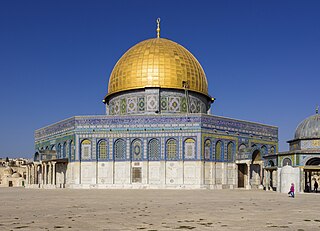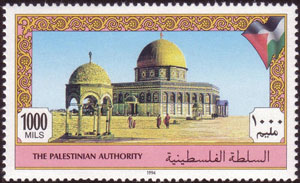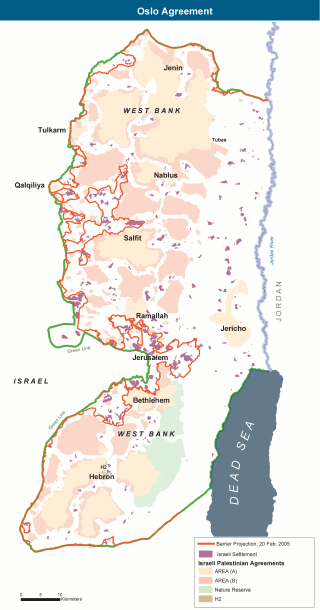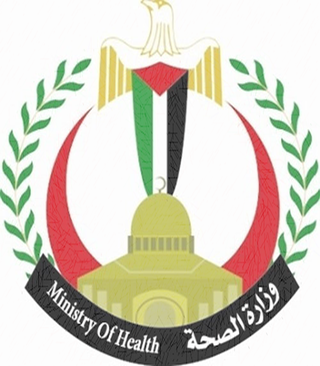Related Research Articles

The Palestinian Authority, officially known as the Palestinian National Authority or the State of Palestine, is the Fatah-controlled government body that exercises partial civil control over the Palestinian enclaves in the Israeli-occupied West Bank as a consequence of the 1993–1995 Oslo Accords. The Palestinian Authority controlled the Gaza Strip prior to the Palestinian elections of 2006 and the subsequent Gaza conflict between the Fatah and Hamas parties, when it lost control to Hamas; the PA continues to claim the Gaza Strip, although Hamas exercises de facto control. Since January 2013, the Palestinian Authority has used the name "State of Palestine" on official documents, although the United Nations continues to recognize the Palestinian Liberation Organization (PLO) as the "representative of the Palestinian people".

The history of the State of Palestine describes the creation and evolution of the State of Palestine in the West Bank and Gaza Strip. During the British mandate period, numerous plans of partition of Palestine were proposed but without the agreement of all parties. In 1947, the United Nations Partition Plan for Palestine was voted for. The leaders of the Jewish Agency for Palestine accepted parts of the plan, while Arab leaders refused it. This triggered the 1947–1949 Palestine war and led, in 1948, to the establishment of the state of Israel on a part of Mandate Palestine as the Mandate came to an end.

The occupied Palestinian territories, also referred to as the Occupied Palestinian Territory and the Palestinian territories, consist of the West Bank and the Gaza Strip—two regions of the former British Mandate for Palestine that have been occupied by Israel since the Six-Day War of 1967. These territories make up the State of Palestine, which was self-declared by the Palestine Liberation Organization in 1988 and is recognized by 145 out of 193 UN member states.

Palestine, officially the State of Palestine, is a country in the southern Levant region of West Asia recognized by 145 out of 193 UN member states. It encompasses the Israeli-occupied West Bank, including East Jerusalem, and the Gaza Strip, collectively known as the Occupied Palestinian territories, within the broader geographic and historical Palestine region. The country shares most of its borders with Israel, and it borders Jordan to the east and Egypt to the southwest. It has a total land area of 6,020 square kilometres (2,320 sq mi) while its population exceeds five million people. Its proclaimed capital is Jerusalem, while Ramallah serves as its administrative center. Gaza City was its largest city until 2023.

The 1949 Armistice Agreements, which ended the 1948 Arab–Israeli War by delineating the Green Line as the legal boundary between Israel and the Arab countries, left the Kingdom of Egypt in control of a small swath of territory that it had captured and occupied in the former British Mandate for Palestine: the Gaza Strip. This period saw the creation of the All-Palestine Government within the All-Palestine Protectorate, an Egyptian client state that lasted until 1959, a year after the Republic of Egypt and the Second Syrian Republic merged to form a single sovereign state known as the United Arab Republic. The Egyptian administration of the Gaza Strip was briefly subsumed by Israel during the 1956 Suez Crisis and ended entirely during the 1967 Arab–Israeli War, after which the territory became occupied by Israel with the establishment of the Israeli Military Governorate.

Tubas is a Palestinian city in the northeastern West Bank, located northeast of Nablus, west of the Jordan Valley. A city of over 21,000 inhabitants, it serves as the economic and administrative center of the Tubas Governorate of the State of Palestine. Its urban area consists of 2,271 dunams. It is governed by a municipal council of 15 members and most of its working inhabitants are employed in agriculture or public services.
The government of Palestine is the government of the Palestinian Authority or State of Palestine. The Executive Committee of the Palestine Liberation Organization (EC) is the highest executive body of the Palestine Liberation Organization and acts as the government. Since June 2007, there have been two separate administrations in Palestine, one in the West Bank and the other in the Gaza Strip. The government on the West Bank was generally recognised as the Palestinian Authority Government. On the other hand, the government in the Gaza Strip claimed to be the legitimate government of the Palestinian Authority. Until June 2014, when the Palestinian Unity Government was formed, the government in the West Bank was the Fatah-dominated Palestinian government of 2013. In the Gaza Strip, the government was the Hamas government of 2012. Following two Fatah–Hamas Agreements in 2014, on 25 September 2014 Hamas agreed to let the PA Government resume control over the Gaza Strip and its border crossings with Egypt and Israel, but that agreement had broken down by June 2015, after President Abbas said the PA government was unable to operate in the Gaza Strip.

The politics of the Palestinian National Authority (PNA) take place within the framework of a semi-presidential multi-party republic, with a legislative council, an executive president, and a prime minister leading the cabinet.

The Palestinian National Authority began in 1994 to issue stamps and operate postal services as authorized by the Oslo Accords.

The following outline is provided as an overview of and topical guide to the State of Palestine:

The Oslo II Accord divided the Israeli-occupied West Bank into three administrative divisions: the Palestinian enclaves as "Areas A and B" and the remainder, including Israeli settlements, as "Area C".
The Palestinian National Authority requires their residents register their motor vehicles and display vehicle registration plates. There are two different registration systems in use: one for West Bank and one in the Gaza Strip.
The water resources of Palestine are de facto fully controlled by Israel, and the division of groundwater is subject to provisions in the Oslo II Accord.

The Civil Administration is the Israeli governing body that operates in the West Bank. It was established by the government of Israel in 1981, in order to carry out practical bureaucratic functions within the territories captured by Israel in 1967. While formally separate, it was subordinate to the Israeli military.

The Oslo Accords are a pair of interim agreements between Israel and the Palestine Liberation Organization (PLO): the Oslo I Accord, signed in Washington, D.C., in 1993; and the Oslo II Accord, signed in Taba, Egypt, in 1995. They marked the start of the Oslo process, a peace process aimed at achieving a peace treaty based on Resolution 242 and Resolution 338 of the United Nations Security Council. The Oslo process began after secret negotiations in Oslo, Norway, resulting in both the recognition of Israel by the PLO and the recognition by Israel of the PLO as the representative of the Palestinian people and as a partner in bilateral negotiations.

Healthcare in the State of Palestine refers to the governmental and private healthcare providers to which residents in the claimed territory have access. Since 1967, there have been improvements in the access to healthcare and the overall general health conditions for residents. Advances in training, increased access to state-of-the-art medical technology, and various governmental provisions have allowed per-capita funding to increase, and therefore the overall health of residents in the region to increase. Additionally, the enhanced access to and funding from international organizations like the World Health Organization, the United Nations, the Palestinian Ministry of Health, and the World Bank Education and Health Rehabilitation Project have contributed to the current state of affairs within the healthcare segment of the Palestinian territories.

Hamas has governed the Gaza Strip in Palestine since its takeover of the region from rival party Fatah in June 2007. Hamas' government was led by Ismail Haniyeh from 2007 until February 2017, when Haniyeh was replaced as leader of Hamas in the Gaza Strip by Yahya Sinwar. As of November 2023, Yahya Sinwar continues to be the leader of Hamas in the Gaza Strip. In January 2024, due to the ongoing Israel–Hamas war, Israel said that Hamas lost control of most of the northern part of the Gaza Strip. In May 2024, Hamas regrouped in the north.

The Battle of Gaza or the Gaza civil war was a brief civil war between Fatah and Hamas that took place in the Gaza Strip from 10 to 15 June 2007. It was a prominent event in the Fatah–Hamas conflict, centered on the struggle for power after Fatah lost the 2006 Palestinian legislative election. The battle resulted in the dissolution of the unity government and the de facto division of the Palestinian territories into two entities: the West Bank governed by the Palestinian National Authority (PNA), and the Gaza Strip governed by Hamas. Hamas fighters took control of the Gaza Strip, while Fatah officials were either taken as prisoners, executed, or expelled. The Palestinian Centre for Human Rights reported that at least 161 people were killed and more than 700 were wounded during the fighting.
The Ministry of Local Government is a governmental body in Palestine that is responsible for overseeing the local government system and ensuring that it functions effectively. The ministry is responsible for providing support and guidance to local government institutions, including municipalities, village councils, and other local authorities.
References
- ↑ "Palestinian Territories" (PDF). OECD . October 2016. p. 2. Retrieved 23 March 2024.